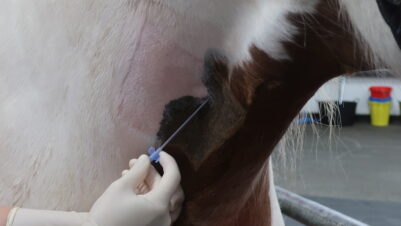
Imagine this clinical scenario: you are presented with a four-year-old male neutered Border Collie previously diagnosed with idiopathic epilepsy that is in status epilepticus. The patient is experiencing severe seizures, so you need to administer emergency treatment that will cease the seizure activity. The severity of the seizures means that you are unable to place an intravenous catheter and must use another route to deliver emergency medication. You consider intranasal midazolam against rectal diazepam as a first-line treatment to achieve cessation of the seizure activity.
The evidence
One paper was identified that directly compares intranasal midazolam (IN-MDZ) to rectal diazepam (R-DZP) in canine patients experiencing status epilepticus. The paper by Charalambous et al. (2017) was a randomised multicentre clinical trial.
Charalambous et al. (2017) studied 35 client-owned dogs with idiopathic or structural epilepsy presenting to a veterinary practice in generalised or focal status epilepticus. Of the patients, 33 presented with generalised tonic/clonic seizures, and two presented with focal seizures. Patients who were experiencing reactive seizures due to a metabolic or toxic cause were excluded from the study. Dogs that had received any drugs before five minutes of continuous seizure activity had passed were also excluded.
The patients were randomly assigned to two treatment groups, one receiving IN-MDZ and the other receiving R-DZP. Regardless of which treatment they received, all patients were hospitalised for continuous observation and monitoring for at least 24 hours following drug administration. In total, 20 patients were assigned to the IN-MDZ treatment group and received 2mg/kg midazolam injectable solution (5mg/ml) administered intranasally. Doses greater than 1ml were divided between both nostrils to reduce drug outflow. Fifteen patients were assigned to the R-DZP treatment group and received 1mg/kg diazepam injectable solution (5mg/ml) per rectum via a needleless syringe, applied as deep as possible into the rectum.
The primary outcomes studied were seizure cessation time, defined as the time between drug administration and seizure cessation, and seizure relapse time, defined as the time between seizure cessation and the onset of the next seizure. Treatment was considered successful if seizure cessation time was less than five minutes and seizure relapse time was more than 10 minutes.
The following outcomes were studied at 10 minutes and 60 minutes post-treatment: heart rate and rhythm, respiratory rate and pattern, blood pressure, oxygen saturation and subjective analysis of sedation and ataxia.
Limitations of the evidence
Since there is only one veterinary study comparing IN-MDZ to R-DZP, the overall strength of evidence is considered weak
Since there is only one veterinary study comparing IN-MDZ to R-DZP, the overall strength of evidence is considered weak. Regarding the study by Charalambous et al. (2017), various limitations can be identified. Firstly, the sample size in this study was too small. The authors of the study carried out a power ranking that found a minimum of 72 patients, with 36 per treatment group, would be required for 80 percent power. The actual numbers fell below this, with 35 dogs overall and group sizes of 20 and 15 dogs, which limits the power of the study.
Secondly, the way the study was designed opened up the possibility of observer bias and human error. Clinicians were not blinded to the treatment that each patient had received, potentially leading to observer bias when defining seizure cessation. Additionally, the definition of a “successful treatment” within the study – seizure cessation within five minutes and no relapse within 10 minutes – relied upon subjective interpretation by the clinician. This left room for human error; for example, continued micromotor activity or focal seizures may have been missed, which would lead to incorrect reporting of seizure cessation. This risk is increased by the fact that the study was multicentre, with each case involving different staff.
Additionally, P-values were only reported for comparisons of “successful treatment” between groups. P-values for other measured outcomes, such as “doctor-to-drug” time and incidence of adverse effects are not reported, which makes it unclear whether the differences between treatment groups are significant at the individual outcome level.
Summary of findings
The success rate for dogs treated with IN-MDZ was 70 percent, while the success rate for R-DZP was 20 percent
The findings of Charalambous et al. (2017) found that IN-MDZ had a significantly greater “success rate” than R-DZP. However, these findings must be considered alongside the limitations outlined above.
The success rate for dogs treated with IN-MDZ was 70 percent (14/20), while the success rate for R-DZP was 20 percent (3/15). IN-MDZ caused more rapid cessation of seizure activity, with a median of 47 seconds compared to 214 seconds for R-DZP. IN-MDZ also proved more effective at preventing relapse, with 21 percent (3/14) of successful cases not relapsing, while 100 percent (3/3) of successful R-DZP cases relapsed.
Difficulties in administration were reported for both treatment groups: in 10 percent (2/20) of IN-MDZ cases and 13 percent (2/15) of R-DZP cases. Sneezing episodes were reported in 35 percent (7/20) of IN-MDZ cases, while none were reported in R-DZP patients.
All dogs in both treatment groups were reported to experience severe sedation and ataxia, which appeared to worsen over the 60-minute monitoring period.
Conclusion
IN-MDZ appears to be safe and effective when used for seizure control in dogs and is a suitable first-line treatment option when intravenous access is not rapidly available
Even though there is not enough evidence to assess the superiority of IN-MDZ over R-DZP for controlling status epilepticus in canine patients, IN-MDZ appears to be safe and effective when used for seizure control in dogs and is a suitable first-line treatment option when intravenous access is not rapidly available.
| The full Knowledge Summary can be read in RCVS Knowledge’s open access journal Veterinary Evidence. |
Disclaimer
The application of evidence into practice should take into account multiple factors, not limited to: individual clinical expertise; patient’s circumstances and owner’s values; country, location or clinic where you work; the individual case in front of you; and the availability of therapies and resources.












